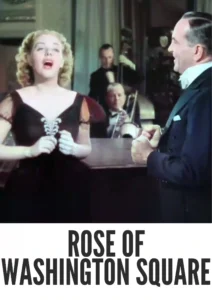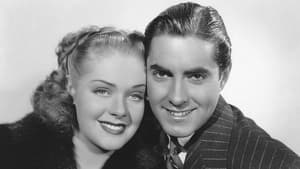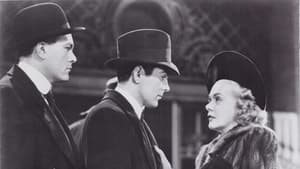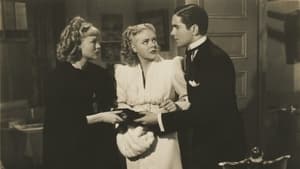Contact: info@alwanfilm.com
Video Sources 0 Views

Synopsis
Rose of Washington Square 1939 Colorized Review: A Musical Drama in Early Color

Introduction
“Rose of Washington Square” (1939) is a striking blend of musical drama and biographical storytelling, set against the backdrop of New York’s theatrical world in the early 20th century. Starring the iconic Alice Faye, Tyrone Power, and Al Jolson, the film is an ode to vaudeville and the early years of Broadway. Despite its surface-level charm as a musical, “Rose of Washington Square” is imbued with deeper themes of love, heartbreak, and resilience. However, the film is perhaps best known for its controversial parallels to the real-life story of singer Fanny Brice, a connection that led to legal battles and added an intriguing layer to its legacy.
Released at a time when color films were still a novelty, “Rose of Washington Square” was one of the many musical dramas that showcased the glamour and spectacle of showbiz. Though originally produced in black and white, the later colorized version opened up the film to new generations of viewers. In this article, we will explore the significance of the early colorized version, examine its impact on the visual storytelling, and delve into the movie’s legacy in the musical genre.
Check The Full Colorized Movies List
Check Our Colorized Movies Trailer Channel
Understanding Rose of Washington Square 1939 Colorized: Director, Cast, and Genre
Directed by Gregory Ratoff, “Rose of Washington Square” marked a pivotal moment in his career. Ratoff, known for his work in both acting and directing, had a knack for balancing large-scale musical numbers with intimate character-driven moments. His direction of “Rose of Washington Square” showcased his ability to convey the glamour of show business while also focusing on the personal struggles of his characters.
The film starred Alice Faye as Rose Sargent, a singer who rises to fame in the vaudeville circuit. Faye, already an established star by the late 1930s, was known for her husky voice, warm on-screen presence, and ability to handle both dramatic and comedic roles. In “Rose of Washington Square,” she shines as the central character, delivering powerful musical performances while also portraying the emotional vulnerability of a woman torn between love and her career.
Tyrone Power played the role of Bart Clinton, a suave gambler who wins Rose’s heart but ultimately causes her downfall. Power, one of the biggest stars of the era, brought a magnetic charm to the role, perfectly balancing the character’s allure and duplicity. His chemistry with Faye added depth to the romantic arc of the film, making their relationship both captivating and tragic.
Al Jolson, in his final major film role, appeared as Ted Cotter, a vaudeville performer who helps guide Rose through the ups and downs of showbiz. Jolson, already a legend due to his pioneering work in sound films such as “The Jazz Singer” (1927), added authenticity to the vaudeville scenes. His performances of songs like “Mammy” and “Toot, Toot, Tootsie” bring an air of nostalgia to the film, cementing its place as a homage to the golden age of American entertainment.
“Rose of Washington Square” fits within the musical drama genre, but it also transcends it by incorporating biographical elements, romance, and the struggles of showbiz. With its sweeping musical numbers and dramatic storytelling, the film represents the height of 1930s Hollywood’s fascination with glamorous, larger-than-life musicals.
Exploring the World of Rose of Washington Square 1939 Colorized: Plot and Characters
“Rose of Washington Square” follows the rise of Rose Sargent, a talented singer who becomes a star in the vaudeville world while navigating her tumultuous relationship with Bart Clinton, a charming but dishonest gambler. The film captures Rose’s journey from an unknown performer to a Broadway sensation, interspersing her personal struggles with vibrant musical performances.
The plot is heavily driven by Rose’s relationship with Bart. Initially smitten by his charm and devotion, Rose’s life begins to unravel as Bart’s illegal dealings and reckless behavior catch up to him. Despite his love for Rose, Bart’s criminal activities lead to his eventual downfall, and Rose is left to pick up the pieces of her career and personal life.
Ted Cotter, played by Jolson, serves as a mentor and friend to Rose, offering support and guidance as she navigates the highs and lows of show business. His role as a vaudeville veteran adds a touch of authenticity to the film’s portrayal of the entertainment industry.
The characters in “Rose of Washington Square” are richly drawn, with Rose standing out as a strong, resilient woman who refuses to be defeated by the betrayals and heartbreaks she faces. Her determination to succeed in her career, despite the personal sacrifices she must make, resonates deeply with audiences and speaks to the timeless themes of ambition and perseverance.
The Art of Film Colorization
Film colorization is a transformative process that involves adding color to black-and-white footage. When “Rose of Washington Square” was later colorized, it brought new life to the musical numbers, costumes, and settings, creating a more immersive visual experience for modern viewers. The process itself is labor-intensive, requiring artists to carefully select appropriate hues for costumes, skin tones, and backgrounds while preserving the integrity of the original film.
For musicals like “Rose of Washington Square,” colorization can enhance the viewing experience by highlighting the vibrancy and spectacle of the performances. The film’s lavish costumes, ornate theater settings, and bustling city streets gain a new dimension in color, drawing the audience further into the world of vaudeville and Broadway.
However, as with any colorization project, there are challenges. The original lighting and cinematography, designed for black and white, may not always translate smoothly to color. This can result in moments where the added hues feel artificial or detract from the film’s visual tone. Nevertheless, the colorized version of “Rose of Washington Square” provides an engaging alternative for those looking to experience the film in a new way.
Early Colored Films: A Brief History
Color films were still a relatively new phenomenon in 1939, though Hollywood had already seen several major breakthroughs in color technology. Technicolor, the process that revolutionized color filmmaking, had been used in films like “The Adventures of Robin Hood” (1938) and “The Wizard of Oz” (1939), showcasing the potential of vibrant color in cinematic storytelling.
However, not every film was shot in color, as it was an expensive and complex process. Black-and-white films remained the norm, especially for genres like dramas and comedies, which didn’t necessarily require the visual spectacle that color provided. The use of color was often reserved for large-scale productions that relied on stunning visuals to draw audiences.
As colorization technology advanced in the decades following the release of “Rose of Washington Square,” studios began colorizing older black-and-white films to appeal to a new generation of moviegoers. While the original version of “Rose of Washington Square” was released in black and white, the colorized version allowed audiences to experience the film in a fresh and visually engaging format.
“Rose of Washington Square” and Its Early Colored Version
The colorized version of “Rose of Washington Square” brought a new dimension to the film’s musical numbers and vaudeville performances. Alice Faye’s glamorous costumes and the vibrant settings of early 20th-century New York burst to life in color, giving modern audiences a more immersive experience of the film’s theatrical world.
However, it’s important to note that the colorization process also altered some of the film’s visual tones. In black and white, the film’s more emotional and dramatic moments are often heightened by the use of shadow and contrast, which is sometimes lost in the colorized version. For example, the scenes depicting Rose’s heartbreak and disillusionment with Bart carry a certain weight in black and white that can feel diminished when viewed in color.
Nevertheless, the colorized version offers a unique opportunity to see the film in a different light—quite literally. For those who enjoy the spectacle of old Hollywood musicals, the colorized version is a visually stunning way to experience the magic of “Rose of Washington Square.”
The Debate Over Film Colorization
The debate surrounding film colorization has been a contentious one, particularly among film historians, critics, and directors. On one side, proponents of colorization argue that it breathes new life into classic films, making them more accessible to modern audiences who might shy away from black-and-white movies. Color can add vibrancy to period costumes, settings, and performances, creating a richer visual experience.
On the other hand, purists contend that colorization alters the original artistic intent of the filmmakers. Directors and cinematographers in the black-and-white era used lighting, shadows, and contrast to create specific moods and visual styles that can be disrupted by the addition of color. In some cases, colorization can make a film feel artificial or detract from its emotional depth.
In the case of “Rose of Washington Square,” the colorization process has its pros and cons. While the musical numbers and vaudeville performances benefit from the added vibrancy, some of the more dramatic and emotionally charged scenes may lose some of their original impact in color. Ultimately, the choice between black and white or color comes down to personal preference.
Examining “Rose of Washington Square” as an Early Colored Film
As an early colorized film, “Rose of Washington Square” provides a fascinating case study in how color can transform the viewing experience. The film’s lavish vaudeville performances, glamorous costumes, and bustling urban settings are all enhanced by the addition of color. In particular, Alice Faye’s musical numbers take on a new energy in color, as her stunning wardrobe and vibrant stage sets pop in ways that black-and-white footage could not fully capture.
However, the film’s emotional core—the love story between Rose and Bart—loses some of its intensity in the transition to color. The stark contrasts and shadows that dominate the black-and-white version help to emphasize the darker aspects of their relationship, particularly Bart’s betrayal and Rose’s heartbreak. In color, these moments feel somewhat softened, as the brighter hues detract from the film’s more somber tones.
Despite these differences, the colorized version of “Rose of Washington Square” remains a visually captivating film. For modern viewers, it offers an accessible and engaging way to experience a classic musical drama, while also serving as a testament to the artistry of early Hollywood.
Influence and Legacy: Rose of Washington Square 1939 Colorized’s Impact on Cinema
“Rose of Washington Square” left a lasting mark on the musical genre, both for its performances and its depiction of the vaudeville era. The film’s combination of music, drama, and romance became a template for many future musical dramas, and Alice Faye’s portrayal of a strong yet vulnerable female lead would go on to inspire countless similar roles in later films.
The film also played a significant role in cementing the popularity of both Faye and Power as Hollywood’s golden couple. Their on-screen chemistry was electric, and the film’s success helped solidify their status as two of the biggest stars of the era.
Director’s Cinematic Legacy: Beyond Rose of Washington Square 1939 Colorized
Gregory Ratoff, while not as well-known as some of his contemporaries, made significant contributions to Hollywood during the Golden Age of cinema. His ability to work across genres—from musicals to comedies to dramas—allowed him to leave his mark on a wide range of films. “Rose of Washington Square” stands out as one of his most well-known directorial efforts, and his work on the film showcased his skill at balancing musical spectacle with intimate character development.
Though his career was cut short by illness, Ratoff’s influence on Hollywood can still be felt today, particularly in the way he blended genre elements to create films that appealed to both critics and audiences alike.
Themes Explored in Rose of Washington Square 1939 Colorized
At its core, “Rose of Washington Square” is a story about love, ambition, and resilience. Rose Sargent’s journey from unknown singer to Broadway star is driven by her determination to succeed, even in the face of personal heartache. The film explores the sacrifices that women, in particular, often had to make in pursuit of their careers during the early 20th century.
The film also touches on themes of betrayal and redemption. Bart Clinton, despite his love for Rose, ultimately betrays her trust, leading to his downfall. Rose’s decision to stand by him, even as her career flourishes and his life unravels, speaks to the complexity of love and loyalty in the face of hardship.
Reception and Controversy Surrounding “Rose of Washington Square” (1939)
Upon its release, “Rose of Washington Square” was met with generally positive reviews, particularly for Alice Faye’s performance and the film’s musical numbers. However, the film became embroiled in controversy when singer and actress Fanny Brice sued 20th Century Fox, claiming that the character of Rose Sargent was based on her life. Brice, whose rise to fame in vaudeville closely mirrored Rose’s story, took issue with the film’s portrayal of her relationship with gambler Nicky Arnstein (on whom the character of Bart Clinton was allegedly based).
While Brice ultimately settled out of court, the lawsuit brought attention to the film’s biographical elements, adding an extra layer of intrigue for audiences.
Where to Watch Rose of Washington Square 1939 Colorized Online
“Rose of Washington Square” is available for streaming on several platforms, including Amazon Prime Video, Apple TV, and Google Play. Both the original black-and-white version and the colorized version are available for purchase or rental, allowing viewers to choose their preferred viewing experience.
FAQs About Rose of Washington Square 1939 Colorized
Q: Is “Rose of Washington Square” based on a true story?
A: While the film is not officially based on a specific person, it bears a strong resemblance to the life of singer Fanny Brice, who later sued the studio for its portrayal of her story.
Q: Where was “Rose of Washington Square” filmed?
A: The film was shot on studio sets in Hollywood, with several scenes designed to evoke the look and feel of early 20th-century New York.
Q: What songs are featured in “Rose of Washington Square”?
A: The film includes several classic vaudeville songs, including “My Man,” “Mammy,” and “California, Here I Come,” many of which are performed by Al Jolson.
Conclusion
“Rose of Washington Square” (1939) remains an enduring classic in the musical drama genre, offering a heartfelt story of love, ambition, and the struggles of showbiz. The film’s powerful performances, particularly from Alice Faye and Al Jolson, ensure its place in the pantheon of Hollywood’s Golden Age musicals.
While the colorized version adds a new dimension to the film’s musical performances, the original black-and-white version retains a certain emotional depth that may be lost in color. Ultimately, “Rose of Washington Square” stands as a testament to the artistry of early Hollywood, blending music, drama, and romance in a way that continues to captivate audiences nearly a century later.



















